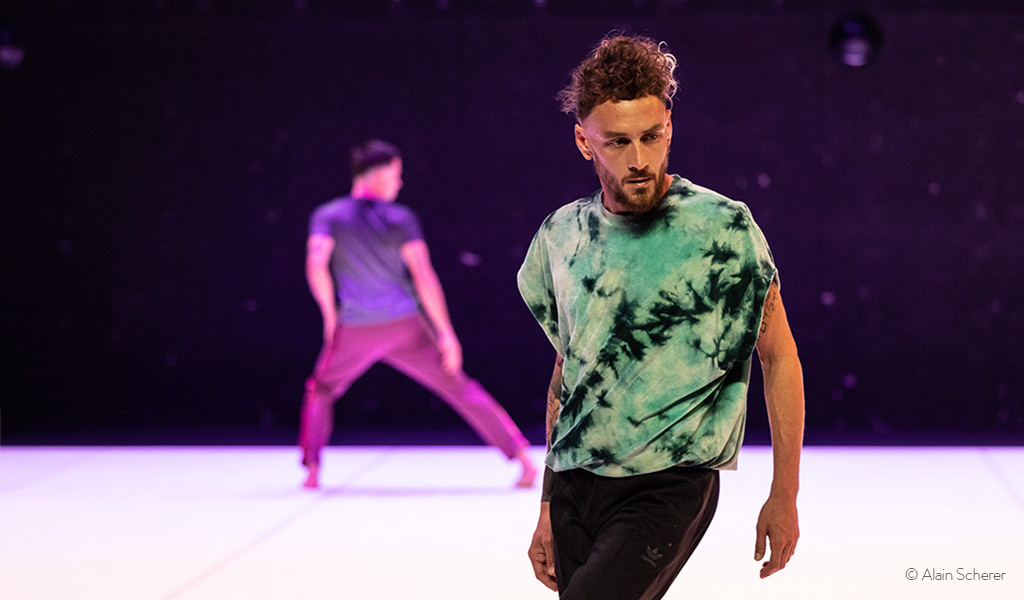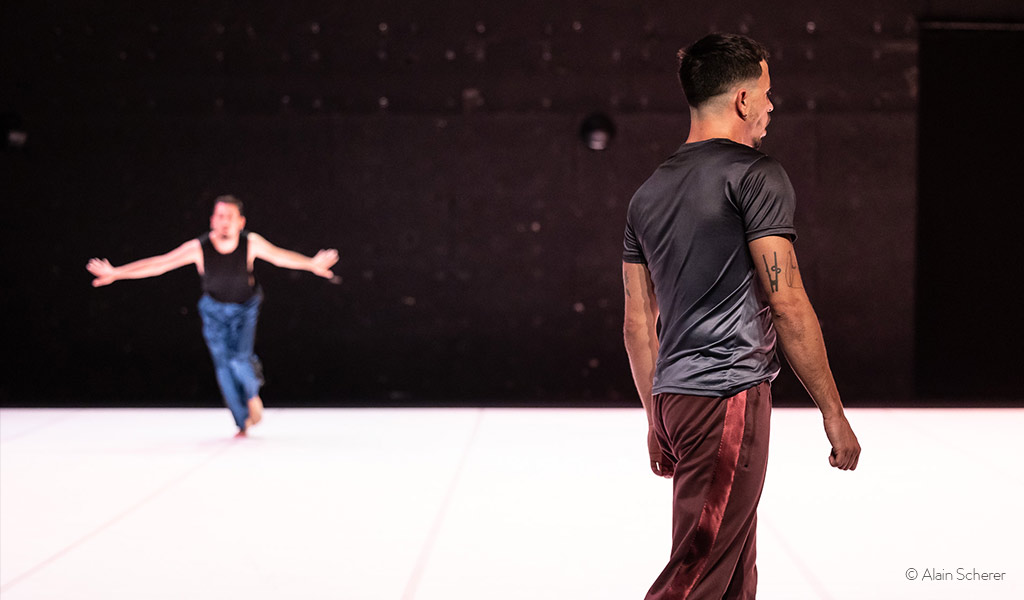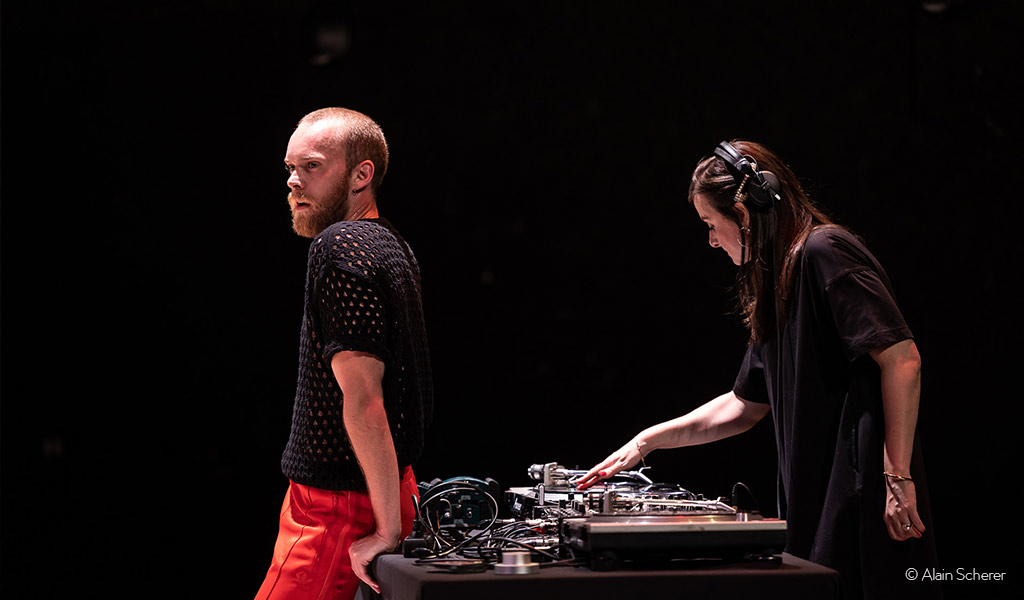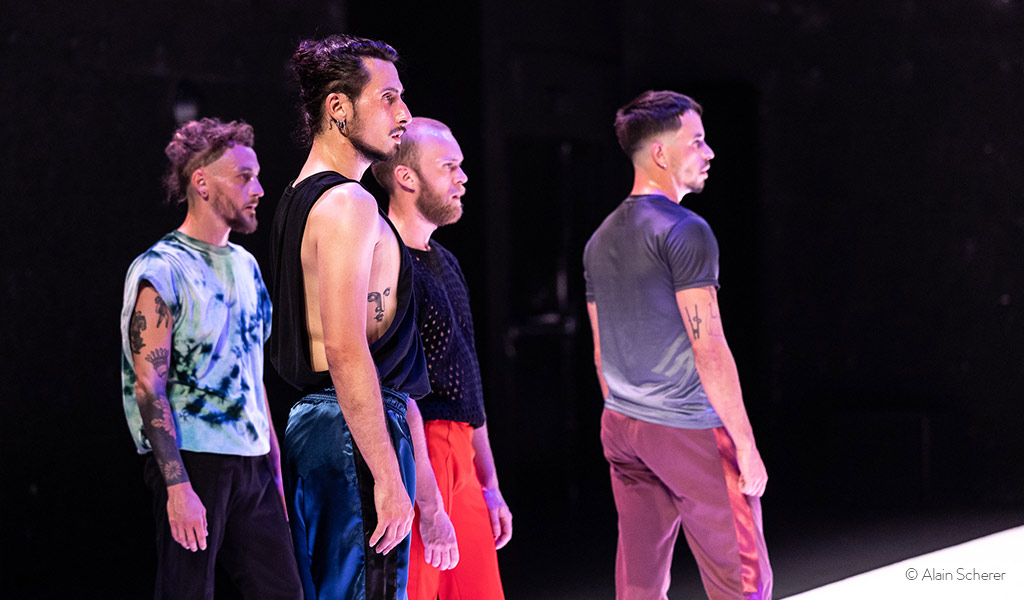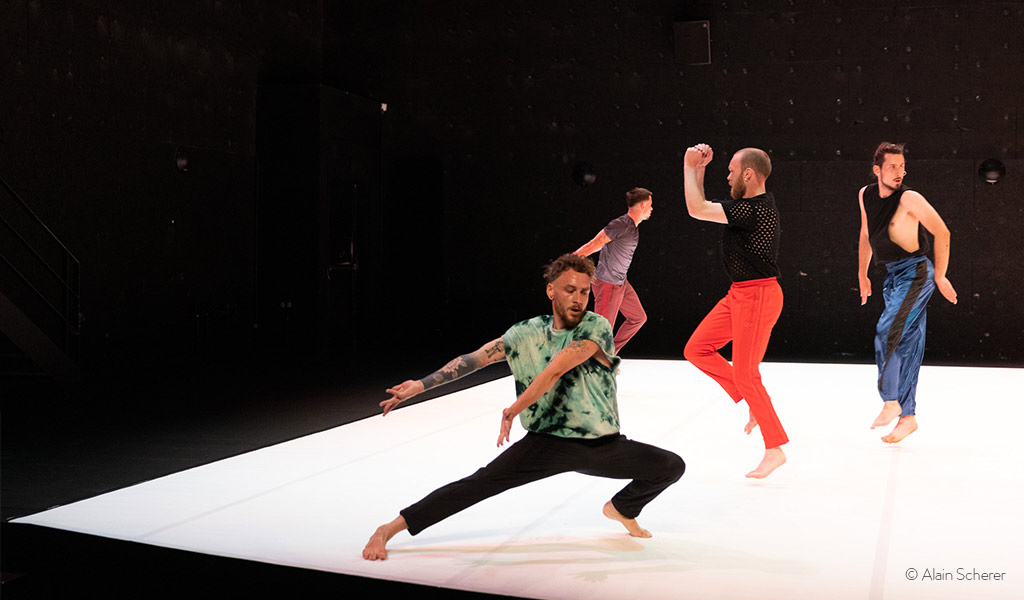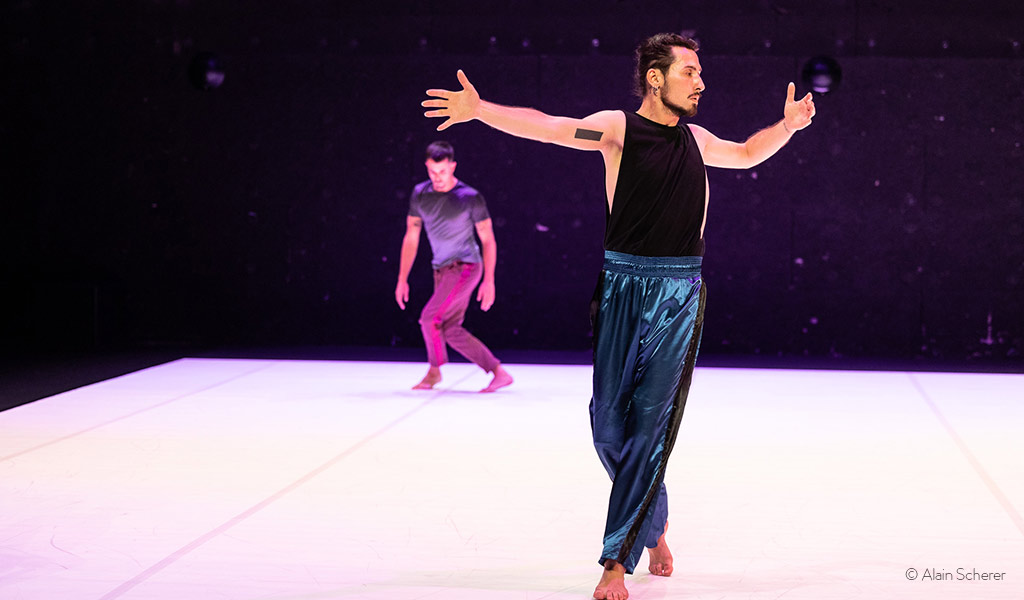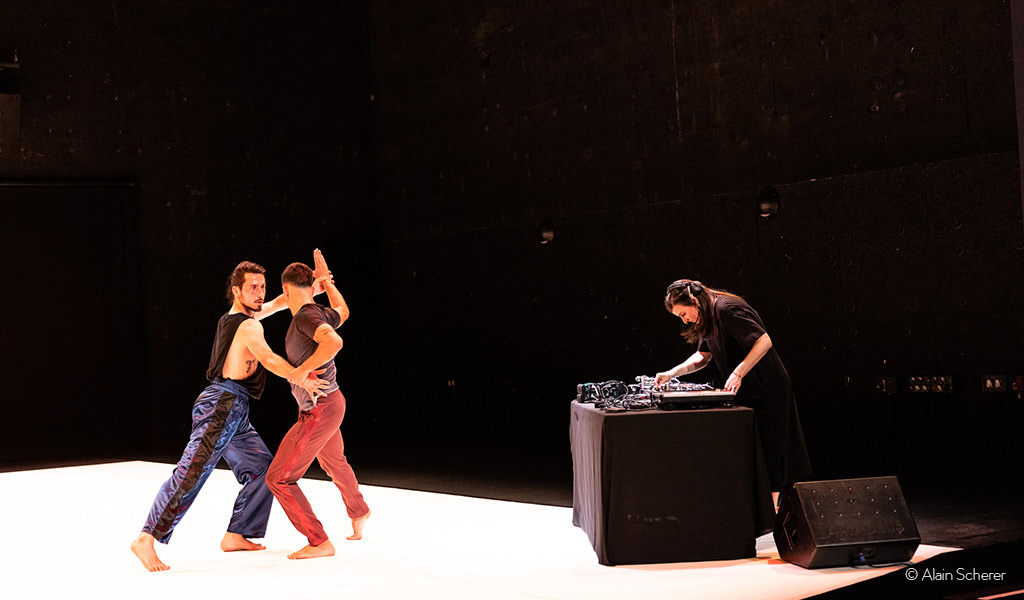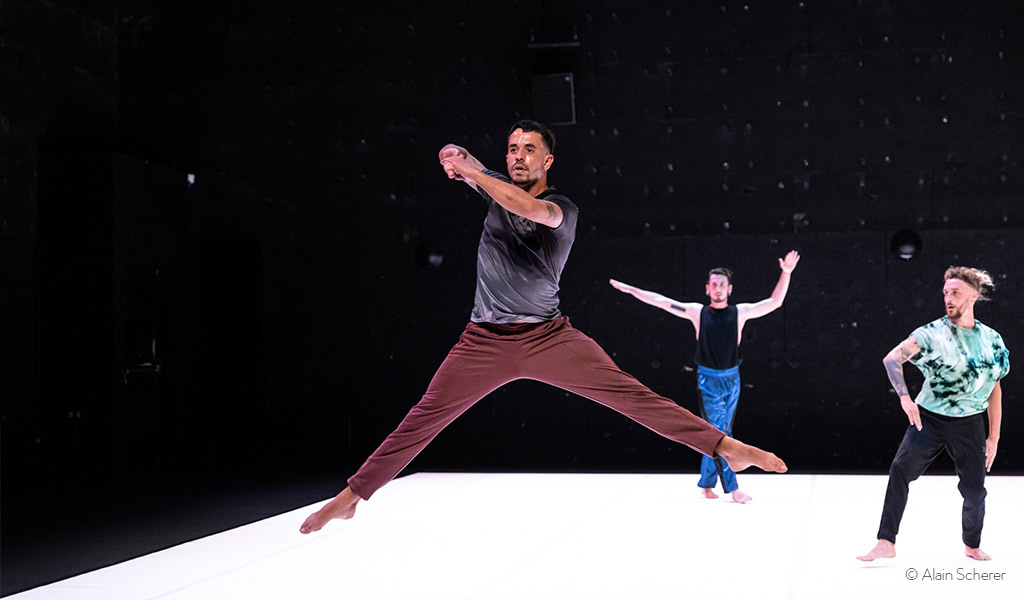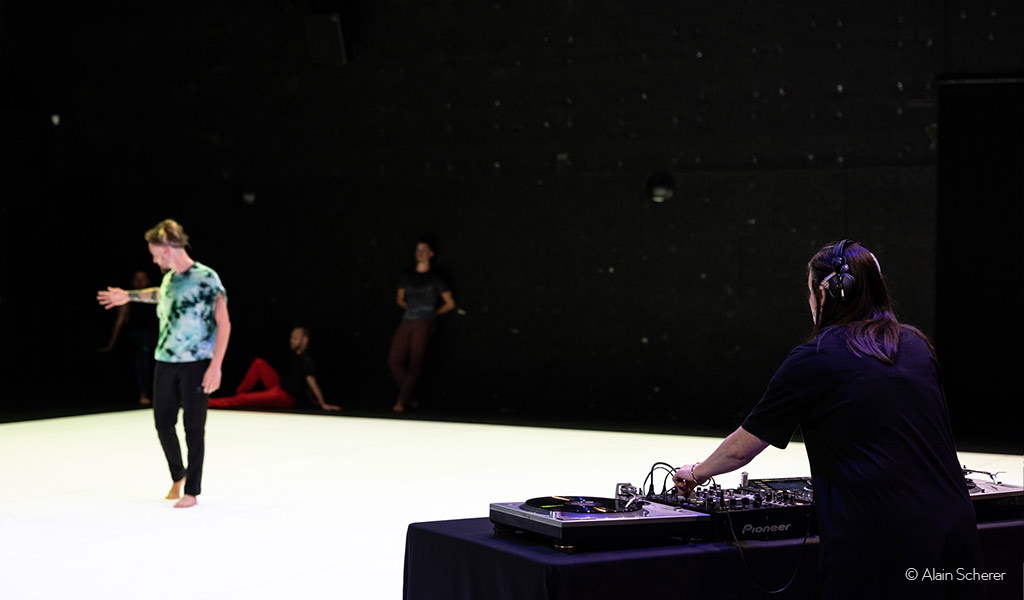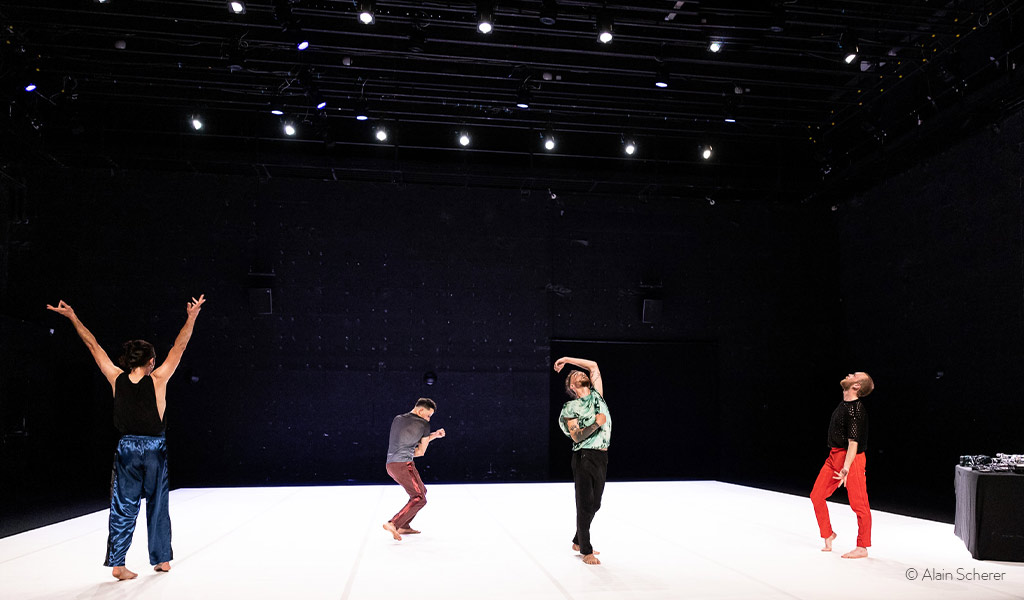Creation
2022
Enthralled by the powerful energy flowing through the work of American painter Cy Twombly, our choreographic project once again borrows its title from one of his works, EMPIRE OF FLORA (1961).
Performed by four men and by a woman DJ, EMPIRE OF FLORA speaks of spring and of life beginning anew, of movement gradually emerging and finally exploding into an abundance of forms, energies, rhythms and spaces.
Our aim is to enable the audience to feel and experience the sensation of springtime through the choreographic structure, the dance and the music.
The performers become generators of energy, transmitters of desire and vitality, and the sensation of springtime becomes tangible and alive in their bodies.
ARTISTIC DIRECTOR, CHOREOGRAPHY: MICHELE MURRAY
ARTISTIC COLLABORATION: MAYA BROSCH, Marie LECA
PERFORMERS: ALEXANDRE BACHELARD, BAPTISTE MENARD, MANUEL MOLINO, JULIEN-HENRI VU VAN DUNG
MUSIC: LOLITA MONTANA (DJ SET)
LIGHTS: CATHERINE NODEN
COSTUMES : LUCIE PATAROZZI
PARTNERS
PRODUCTION: PLAY / MICHÈLE MURRAY – ASSOCIATION STELLA
COPRODUCTIONS AND SUPPORTS: MONTPELLIER DANSE / CCN NANCY – BALLET DE LORRAINE – ACCUEIL STUDIO 2021 -22 / ARTS VIVANTS – CONSEIL DÉPARTEMENTAL DE L’HÉRAULT THÉÂTRE D’O MONTPELLIER / THÉÂTRE LA VISTA – LA CHAPELLE – VILLE DE MONTPELLIER / PÔLE DE DÉVELOPPEMENT CHORÉGRAPHIQUE MONTPELLIER MOSSON
PUBLIC SUPPORT: DRAC OCCITANIE PYRÉNÉES MÉDITERRANÉE / RÉGION OCCITANIE PYRÉNÉES MÉDITERRANÉE / VILLE DE MONTPELLIER
© Alain SCHERER
PRESS EMPIRE OF FLORA
Michèle Murray’s luminous tenacity at the Montpellier Dance festival
July 02, 2022 | By Gerard MAYEN TOUTE LA CULTUREIntelligence of composition and intelligence of the dancers’ performance skills illuminate EMPIRE OF FLORA, a new piece by the Montpellier-based choreographer.
Jean-Paul Montanari, director of the Montpellier Dance Festival, is one of the maintainers of the great Cunningham tradition, hailing the founding influence of the New York master on a great lineage of Western contemporary dance. We believe that this plays a role in his attachment to Michèle Murray’s work. This mature choreographer, Franco – American by origin, studied dance with Merce Cunningham. Today it is from Montpellier (a city in which are based no less than twenty significant companies) that she develops a body of work that is wonderfully indifferent to all fashionable effects.
EMPIRE OF FLORA is her latest creation for the forty-second edition of the Montpellier Dance Festival. On stage, there is a woman at the turntables, and four men. We fully agree with Michèle Murray’s comment on this subject: ‘The cast was not deliberately planned as such (according to gender issues or other); however, in hindsight, this solution feels right.’
To us, this quotation resonates subtly with the overall logic of this work: EMPIRE OF FLORA seems magnificently mastered, at the height of compositional intelligence. But at the same time, this intelligently thought-out composition results in a simple luminous and light texture. The composition we are talking about weaves together two principles that one might think are antagonistic: on the one hand, the fixing of very exact rules in a pre-determined composing of the dance, and on the other hand, space continuously left to instant composition.
Returning to Merce Cunningham, we remember some of his thoughts, and his saying, in substance, that he prefers deploying devices on stage that allow the beauty of the world to reveal itself, and not to try to impose forms supposed to represent beauty. This is what we feel in EMPIRE OF FLORA, which is due to a delicate intelligence of the performing of the dance (also due to the specific way choreographer Michèle Murray has of directing the dancers, underlining the great trust that characterizes the artistically very mature relationship between these four young men and herself).
Concerning the dancers, Michèle Murray requires technical rigor, as well as their acceptance to take on the great responsibility of choice in the instantaneous writing. The piece makes them settle very patiently in its texture; as well as, in the same way, they observe long quiet moments on many occasions. The dancers generate this piece, as much as they let it live. There is never any spectacular overkill, which overloads so many other dance pieces, trapping the relationship with a spectator subjected to a predictive emotion (Batsheva anyone?)
The movements are nevertheless dynamic and light, unfolding in a great ease of gravity management. The gestures have the time to exist in their essence. Most of the scores are performed individually – except for a few duets and lifts – in a vertical dance and in a rather cosmic circulation of the whole. This dance is clear without being voluble… The essence of this piece lies in the active co-presence of people developing the finesse of a language simply and precisely. Nothing more to add.
The relationship to the music has a lot to do with this. Coming from the bubbling techno scene of the region, DJ Lolita Montana produces a beautifully aerial set, devoid of any cliché, even if the sounds, by nature, inspire a radiant energy. In all good Cunninghamian principle, the four dancers do not have the mission to come and ape the music. Certainly, they will also take the path of a progressive, asymptotic elevation, but which is above all a matter of wide, translucent, and respectful breathing.
Watching EMPIRE OF FLORA, we felt that this aesthetic lives somewhat cut off from our time, even from the world, as if maintained in a garden of elegance. But in a dance landscape that seems so busy looking for itself without finding itself, this form of distance still ended up seeming infinitely right, tenacious, and practically irreplaceable.
OFFSHORE MAGAZINE – Jean Paul GUARINO – July 2022
After creating her successful dance piece WILDER SHORES in 2020, Michèle Murray creates EMPIRE OF FLORA and testifies of her still strong attachment to choreography as an art form as well as of a respectful emancipation towards its history.
The DJ enters the stage and, standing behind her turntables, immediately imposes a rhythm of sustained electro loops, as if to put dancers and spectators in condition, initiating a form of suspense. What in the world will the dancers be able to do on such music which doesn’t need anything else in order to transmit irresistible energy?
Two music pieces later, one dancer appears, followed by a second one, then a third and a fourth, nonchalantly, as if to contradict the rhythmical music, as if to tame it, to master it, at the least not submit themselves to it. In the manner of a warm-up, the contrast between the explosive energy of the turntables and the contained energy of the dancers is sensual. Here, we are not on a dancefloor, and the desire for battle, the wish to let everything out, the drive towards dancing in unison … all this will have to wait. The dancers are going to offer themselves with parsimony, with measured power, as a dancing oxymoron. We suspect choreographic rules are being respected, and then quickly forgotten, even going unheeded; desire doesn’t obey to anything, each dancers has his unbridled path and manner, his own baroque vocabulary, his own history. Like sketches, duos also appear, or it might be more apt to describe the dancers as pairs, or couples. The encounters between the dancers are perfect, there is nothing conventional nor ambiguous about the duos, everything exists for the dance only. Lifts, jumps, Michèle Murray loves abundant dance, and she choreographs it lovingly.
There are also moments of rest, so as to avoid any narrative, and in order to stick with the subject, namely dance, once again. Right until the end, the dancers, mastering and restraining their bodies, -bodies which are subjected to a choreographic composition that seems to have no syntax, but its own effervescent logic, -, the dancers will resist the exuberance and the vital lyricism of the musical whirlwind, so as to better impose their own power, until the stage backlight, until nightfall.
I rarely linger on technical aspects nor on individuals, but I would like to point out once again, in this new choreography as in her former one, the refined lighting of Catherine Noden, the quality of DJ Lolita Montana‘s set, and the improbable tender feeling induced by these four strange dancers seemingly appearing from who knows where.
RES MUSICA MAGAZINE / July 2, 2022, by Delphine Goater / Montpellier Danse, clubbing or not clubbing
Two stages, two atmospheres, both reminiscent of clubbing and partying, at Montpellier Danse, with Ohad Naharin’s creation ‘2019’ for the Batsheva Dance Company and the performance EMPIRE OF FLORA, by Michele Murray.
For EMPIRE OF FLORA, her new creation at Montpellier Danse Festival, the Franco-American choreographer based in Montpellier, Michèle Murray, confronted a male quartet on the stage of the Théâtre La Vignette with a DJ set by the young Lolita Montana. Dancers and DJ each evolve in their own universe, and the meetings between dance and music occur incidentally, during unisons or sudden accelerations. Four very good dancers, four different masculinities on the bare stage. With a sustained attention to each gesture, a quality of movement and a feline energy, the four dancers test themselves, confront each other, compare themselves, as in a fashion show. Next to them, the DJ mixes a set whose intensity increases and then decreases. There is a certain vanity in this fascinating parade of male appearances, from the pose to the posture. But Michèle Murray does not fall into the trap, concentrating on movement alone, in an imperturbable objectivity.
SPINTICA MAGAZINE – Marie REVERDY – July 2022
After WILDER SHORES presented during the 41st edition of the Montpeller Danse festival, Michèle Murray continues her work inspired by artist Cy Twombly’s paintings. In Empire of Flora (1961), the color pink predominates. One feels, left on the canvas, the trace of the ardor and the heat of the gesture of painting. Empire of Flora is also the title of a painting by Nicolas Poussin (1631) referring to an allegory of spring and fertility used in Greek-Roman mythology.
Cy Twombly and springtime in its abundance
It all starts with the theater space, lit in pink, and the live music of DJ Lolita Montana, whose turntables located at the side face the empty stage. The first dancer enters. He focuses mainly on ample and open arm movements, from time to time we see a 5th ballet position appear, as an allusion to the classical training that Michèle Murray followed during her dance education in Düsseldorf. Working on a horizontal axis, pivoting the torso as if to embrace the totality of the here and now, he will be joined by the other dancers who will enter one after the other.
On this dancefloor, it is forbidden to touch each other; on this dance floor, each performer explores movement, repeats a gesture, sketches a choreographic phrase before deploying a rhetoric. A dancefloor consisting of solo dances, before a few glances are exchanged (without theatrically playing this exchange), before a few unisons emerge (without us having the impression of a rendezvous) and, finally, before a few duos appear (without these being presented as the apotheosis of spring). The piece abounds in choreographic details, inscribed in the bodies and in space. Dazzling references seem to emerge from the vivacity of the bodies. Everything seems to be planned as much as fortuitous, like the definition of life given by Jacques Monod, born between ‘chance and necessity’. There is something jubilant in this piece, something delightful. Spring has no landscape, it has no smell, it has no face, it is a contradictory state, situated somewhere between power and grace.
Merce Cunningham and jubilant freedom
Michèle Murray claims the heritage of Merce Cunningham with whom she trained. The geometric structuring of the stage, the facial expression and the performing modalities are the most visible aspects of this heritage. Of course, there is also the idea of freedom lying in constraint and rigor, as a means of emancipation. Finally, there is the absence of a subject: the choreography takes its starting point in the relationship between the dancers’ bodies and the stage, and is constructed through a generative, combinatory process. To define her approach, Michèle Murray speaks of instant composition and likens it to how language functions: a stock of vocabulary composed by each dancer and rules of composition (syntax) that are then applied onstage. From there, the number of possibilities becomes infinite, and creativity becomes dialectic, between choice and necessity: ‘As soon as we start establishing certain rules, the following rules are put in place almost by themselves. And from a certain point on, it is no longer we who direct the piece, it is the piece that directs itself’ explains Michèle Murray during an interview given in February to the CCN – Ballet de Lorraine.
The music has a certain independence from the dance, in a form of dialogue that, like the dancers between each other, will move from one relationship to another, from one preposition to another: with, besides, against, despite.
The end of the piece arrives, something returns, like a cycle, but not identically…

